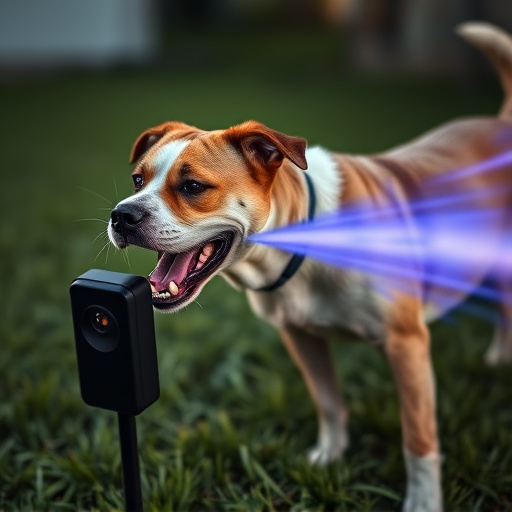Handheld dog deterrents use specific high-frequency sounds (3000Hz – 8000Hz) unpleasant to dogs to encourage them to avoid certain areas. With adjustable coverage areas from 50 to 150 square feet and ranges up to 30 feet, these devices offer flexible protection for gardens, patios, and more. Ideal for parks, gardens, and diverse environments, they provide a humane alternative to fixed systems without causing harm to dogs.
Looking to protect your space from unwanted dog intrusions? Discover the power of dog repellers, a convenient and effective solution. This article guides you through the technology behind these devices, focusing on coverage area and range to ensure optimal protection. Explore the benefits of handheld dog deterrents for ultimate control and portability. Learn about the science behind frequency ranges that deter dogs effectively, keeping your territory safe.
- Understanding Dog Repeller Technology: How It Works
- Coverage Area and Range: What to Expect
- Handheld Devices: Convenience and Portability
- Effective Frequency Ranges for Deterring Dogs
Understanding Dog Repeller Technology: How It Works
Dog repellents, also known as dog deterrents, use specific sound frequencies to create an unpleasant auditory experience for dogs, encouraging them to avoid certain areas. These devices emit high-frequency sounds that are typically above the human hearing range but can be detected by dogs. When activated, they project these sounds, which can vary in tone and intensity, effectively creating a “no-go” zone for canine intruders.
The coverage area of handheld dog deterrents is an essential consideration. These devices often offer a customizable range, allowing users to set the boundaries of their desired exclusion zone. Whether it’s for protecting your garden from stray dogs or keeping your pet from entering specific rooms, understanding the frequency and reach of these repellers ensures effective protection.
Coverage Area and Range: What to Expect
The effectiveness of a handheld dog deterrent, in terms of its coverage area and range, is a key consideration for any potential buyer. These devices emit specific frequencies designed to deter dogs from approaching or engaging with certain areas. The coverage area can vary widely depending on the model and manufacturer, but typically ranges from 50 to 150 square feet (or approximately 4.6 to 13.9 meters squared). This means that a single device might suffice for smaller backyards or indoor spaces, while larger areas may require multiple units strategically placed to ensure comprehensive protection.
When assessing the range of these devices, it’s important to understand that frequency signals can be affected by various factors, including walls, weather conditions, and interference from other electronic devices. Most handheld dog repellents operate on frequencies between 400-1000 Hz, which are generally effective up to about 30 feet (or roughly 9 meters) in open spaces. However, range can be reduced by physical barriers, so for optimal performance, it’s recommended to keep the device within direct line of sight and proximity to the area you wish to protect.
Handheld Devices: Convenience and Portability
Handheld devices offer a convenient and portable solution for dog deterrents, making them an excellent choice for various applications. These compact tools emit specific frequencies that are unpleasant to dogs, encouraging them to stay away from treated areas. The portability of handheld devices allows users to easily manage and expand their coverage area as needed. Whether you’re walking your own dog in unfamiliar territory or managing a public space, these devices provide an effective and non-harmful way to deter canine intrusions.
Compared to larger, fixed systems, handheld dog repellers offer greater flexibility. They can be used in diverse settings—from parks and gardens to patios and porches—without the need for extensive installation. This portability also means users can easily adjust the frequency settings to suit different environments and dog breeds, ensuring optimal effectiveness without causing any harm to animals.
Effective Frequency Ranges for Deterring Dogs
Dogs, with their keen senses, can be deterred from specific areas using targeted sound technology. The effective frequency range for dog deterrents typically falls between 3000Hz and 8000Hz. These high-frequency sounds are often unpleasant to dogs, mimicking the sounds they naturally avoid, like alarm calls from other dogs or certain environmental noises. This technology offers a humane and non-invasive solution, as it does not harm or cause physical pain to the animals but effectively creates an area where dogs are less likely to enter, such as gardens, patios, or specific rooms in homes.
Handheld dog deterrents, for instance, can project this range of frequencies over a defined coverage area, allowing users to control and protect their spaces. The portability of these devices makes them convenient for both temporary and permanent installations, catering to various needs and environments. Whether it’s a small backyard or a larger property, the right handheld dog deterrent with an effective frequency range can ensure peace of mind by keeping dogs at bay.
When it comes to choosing a dog repeller, understanding its coverage area and effective frequency range is key. Handheld devices offer convenience and portability, allowing you to deter unwanted canine visitors effectively from various distances. By targeting specific frequency ranges, these tools can create an uncomfortable sensation for dogs without causing harm. Select a device suited to your needs based on the size of your space, keeping in mind that a broader coverage area may be required for larger properties or areas with obstructions. A handheld dog deterrent is a practical solution for those seeking a hassle-free and humane way to protect their property from unwanted four-legged intruders.
